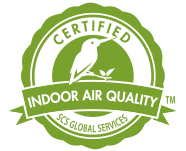The Importance of Indoor Air Quality for Healthier Spaces

Many people think of air pollution as a concern only when outdoors. But indoor air can be polluted too. In fact, the air we breathe indoors is typically two to five times more toxic than the air outside due to poor ventilation and off-gassing of toxic chemicals from products ranging from flooring to paint to furniture and cleaners.
Indoor air quality is a vital yet easily overlooked issue that impacts occupant well-being. The U.S. Environmental Protection Agency (EPA) estimates that Americans spend 90 percent of their time indoors. And they spend much of that time in built environments such as schools, workplaces, and gyms.
Poor indoor air quality has been demonstrated to have long- and short-term effects on human health, including respiratory diseases, heart disease, and cognitive deficits. The EPA along with the American Lung Association and World Health Organization view indoor air pollution as one of the greatest threats to human health.
Because they are still growing and are more vulnerable to hazardous environmental exposures, children are at greater risk of developing health problems due to poor indoor air quality. Indoor pollutants such as certain Volatile Organic Compounds (VOCs), pesticides and allergens are more harmful to younger people.
According to the EPA, 20 percent of the U.S. population, approximately 55 million people, spend a majority of their time in more than 120,000 schools. Roughly half of these schools have indoor air quality problems, posing a health risk not only to children but also to educators. Asthma, which has been linked to poor indoor air quality, is the leading cause of school absences.
Indoor air quality can negatively impact adults too. A 2015 Harvard study found that occupants in buildings with low VOC levels scored 61 percent higher on a test measuring critical thinking abilities than those in buildings with typical VOC levels. When increased ventilation rates were added to the equation, scores grew by 101 percent, a significant improvement.
The products that go into the construction of a building play a crucial role in indoor air quality. Many floor coverings and wall treatments off gas potentially dangerous VOCs long after construction has been completed. As such, one of the keys to establishing and maintaining healthy indoor air quality is using materials with low or now VOCs during construction and renovation.
When it comes to the kinds of guarantees needed to ensure the highest level of indoor air quality, SCS Global Services has become the standard. The organization applies rigorous science to its third-party certification, requiring that products undergo testing by independent labs to ensure compliance with CDPH/EHLB Standard Method V1-1 for VOC emissions of concern.
Polyvision’s CeramicSteel has attained the SCS Indoor Advantage Gold™ certification, supporting a healthy indoor environment by meeting strict indoor air quality (IAQ) chemical emission limits for volatile organic compounds (VOCs). CeramicSteel is a no VOC product, an important advantage when considering building products to be installed in interior applications.
Polyvision has been committed to indoor air quality for longer than the Indoor Advantage Gold™ certification has existed, and has long led the industry in sustainability and wellness initiatives.
As a company, we understand that preserving health and well-being along with implementing sustainable practices are vital in today’s global economy, and strive for continuous improvement in all areas of environmental stewardship. That’s why we do everything possible to ensure that schools, hospitals, businesses, and other spaces are as good for the environment as they are healthy for the people who live, work, and learn in them.
Learn more about our sustainability practices and indoor air quality certification.

